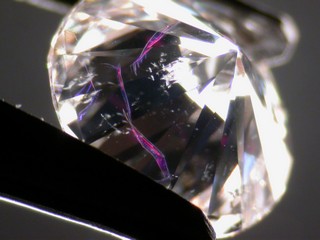Fracture Filling in Diamonds: What It Is and How It Works
Fracture filling is a treatment used to improve the clarity and appearance of diamonds that have visible fractures or cracks. The process involves filling the internal fractures with a transparent substance, often resin or glass-like material, to make the cracks less visible to the naked eye. This can enhance the diamond’s clarity and overall aesthetic appeal, but it also comes with potential risks.
How Fracture Filling Works
Identification of Fractures:
Diamonds that have visible fractures or cracks (called inclusions) are first carefully examined under magnification.
The fractures are identified as imperfections that affect the diamond’s clarity and appearance.
Application of Filling Material:
The fracture is then filled with a clear, transparent substance (such as resin or glass) that closely matches the diamond’s appearance.
The resin is inserted into the fracture under heat and pressure, causing it to bond with the diamond.
Result:
The filled fracture becomes less visible and may be nearly invisible to the naked eye, enhancing the clarity and visual appeal of the diamond.
The treatment improves the diamond’s appearance by making the cracks less noticeable, and it can also enhance light dispersion.
Benefits of Fracture Filling
Improved Clarity:
The main benefit of fracture filling is that it makes fractures less noticeable, effectively improving the diamond’s clarity grade.
Lower Cost:
Fracture-filled diamonds tend to be less expensive than untreated diamonds with similar features, making them a more affordable option for buyers looking for a larger diamond or one with fewer visible flaws.
Appearance Enhancement:
Filling fractures can lead to a brighter, cleaner diamond that has an appearance similar to a higher-clarity stone, especially when the fractures are in highly visible areas.
Risks and Drawbacks of Fracture Filling
Lower Durability:
While the resin fills the fractures, it does not make the diamond any stronger. In fact, the treatment can weaken the diamond by reducing its natural resistance to breakage. The filling material is not as tough as the diamond itself and can be damaged under pressure or impact.
Potential Discolouration:
Over time, the filling material can discolour or become visible if it breaks down. The resin may change colour, potentially making the fracture more noticeable than before.
Disclosure Requirement:
Diamonds that undergo fracture filling should be disclosed as such. Ethical dealers and industry standards require that fracture-filled diamonds be clearly labelled, and the buyer must be informed about the treatment.
Decreased Resale Value:
Because fracture-filled diamonds are considered to be less valuable than untreated diamonds, they may not retain their value as well. Additionally, the filled fractures could affect future appraisals or resales.
Fracture-Filled Diamond Grading and Certification
Disclosure on Certificates:
A diamond that has been fracture-filled will often be noted on the certification report, and it’s important for both buyers and sellers to know whether the diamond has been treated. The GIA (Gemological Institute of America), AGS (American Gem Society), and other grading labs will indicate if a diamond has been treated with fracture filling.
Impact on Clarity Grading:
Fracture filling can temporarily improve the clarity grade of a diamond. For example, a diamond with visible cracks (SI2 or I1 clarity) may appear VS1 or better after the treatment. However, this clarity improvement does not last indefinitely, and the filled fracture will not make the diamond equivalent to a naturally flawless diamond.
Ethics and Transparency in Fracture Filling
Full Disclosure:
Reputable jewellers and diamond dealers are required to disclose the fracture-filling treatment to buyers, as it affects the diamond’s value and integrity.
Buyers should always ask whether a diamond has been treated in this way and check the certificate for any mention of the treatment.
Long-Term Considerations:
While fracture filling can enhance the appearance of a diamond, buyers should be aware that the treatment could be compromised over time, especially with regular cleaning or exposure to high heat or harsh chemicals.
Should You Buy a Fracture-Filled Diamond?
When to Consider a Fracture-Filled Diamond:
If you are looking for a larger diamond or a diamond with better clarity at a lower price, a fracture-filled diamond can be a viable option. Just be sure to understand the risks and limitations of the treatment, especially with regard to durability and long-term appearance.
When to Avoid a Fracture-Filled Diamond:
If you are concerned about the diamond’s long-term durability, resale value, or if you prefer a diamond that has not been treated in any way, it’s best to avoid fracture-filled diamonds.
